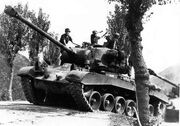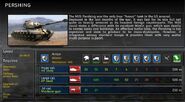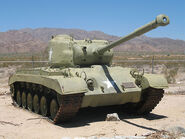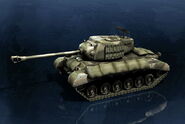| “ | Step on it, lets roll! Yeah, get some! - Pershing |
” |
The M26 Pershing was the only true "heavy" tank in the US arsenal. Deployed in the last months of the war, it was fast for its size but not quite as heavily armored as its heaviest foreign tank counterparts. The M26 could make a difference with its excellent 90mm gun, which was deadly to enemy tanks and buildings.
Though an effective battle tank, the Pershing is too expensive and slow to produce to be mass-deployable. However, if integrated among standard troops it provides them with very useful multi-purpose support. Most of other factions' heavy tanks are more suitable for defense, but the Pershing is a hybrid as it is suitable for offense tactics because of its range and its speed (better than most other heavy tanks), and because of its strength is also good for defense tactics.
Overview[]
- Same rule applies to all heavy tank productions, and to the Pershing as well: at least three Armor Base for efficient training time and many Administrative Buildings are required to efficiently produce Pershings and keep up the economy.
- Since the Pershing is the only "heavy" tank in the American arsenal, using it in both defense and offense can be quite effective since it had good armor, good firepower and a fast speed for a heavy tank, highlighting the versatility of this tank.
- Rule of using America: numbers are everything. Since Pershings are rather weaker to other foreign tanks namely Tiger 1 and Tiger 2 and the Is-3 and most super-heavy tanks, using Pershings in numbers are highly recommended to supplant the offsets.
- America is a very versatile and mobile force, and this applies to most units in America, therefore combining the Pershing with the M19 mobile AA, the M40 heavy armored artillery and the M36 tank destroyers, America can have a very versatile armored force to take out the enemy.
- Researching this tank is absolutely necessary to counter faster enemies so they can't take out the armor bases.
History[]

T23 (Pershing prototype) with production cast turret mounting 76mm M1A1 gun. The T23 turret would be used for the 76-mm M4 Sherman. Note the vertical volute spring suspension.
The Heavy Tank M26 Pershing was an American heavy tank used briefly during World War II and also in the Korean War. It was named after General John Pershing, who led the American Expeditionary Force in Europe in World War I.
Development of the M26 during World War II was prolonged by a number of factors, the most important being opposition to the tank from Army Ground Forces (AGF). As a result, only the initial 20 M26 (T26E3) tanks deployed to Europe in January 1945 saw combat in World War II. The M26 and its improved derivative, the M46 Patton, both saw more combat in Korea. The M26 was underpowered and mechanically unreliable and so was withdrawn from Korea in 1951, in favor of the M46, which had a more powerful engine.
The heavy U.S. tank losses in the Battle of the Bulge against a concentrated German tank force mostly composed of some 400 Panther tanks, as well as Tiger II tanks and other German armored fighting vehicles, revealed the deficiencies in the M4 Shermans and tank destroyers on the U.S. side. On 22 December 1944, while the battle still raged, the brand new T26E3 tanks were ordered to be deployed to Europe. The unexpected German tank attack had settled the question once and for all as to whether the T26 was needed. Twenty were sent in the first shipment, arriving at the port of Antwerp in January 1945. They were given to the 1st Army and split between the 3rd and 9th Armored Divisions. A total of 310 T26E3 tanks would be sent to Europe before VE Day, but only the first 20 would see any combat action.

U.S. Army photo of an M26 Pershing
In February 1945, General Gladeon Barnes, chief of the Research and Development section of Army Ordnance, personally led a special team to the European Theater, called the Zebra Mission. Its purpose was to support the T26E3 tanks, which still had teething problems, as well as to test other new weapons.
After training the tank crews, the T26E3 tanks were first committed to combat on 25 February, with the 3rd Armored Division, in the fighting for the Roer River. On 26 February, a T26E3 named Fireball was knocked out in an ambush at Elsdorf while overwatching a roadblock. Silhouetted by a nearby fire, the Pershing was in a disadvantageous position. A concealed Tiger tank fired three shots from about 100yd (91m). The first penetrated the turret through the machine gun port in the mantlet killing both the gunner and the loader. The second shot hit the gun barrel causing the round that was in the chamber to fire with the effect of distorting the barrel. The last shot glanced off the turret side taking off the upper cupola hatch. While backing up to escape, the Tiger became entangled in debris and was abandoned by the crew. Fireball was quickly repaired and returned to service on 7 March.
Shortly afterward, also at Elsdorf, another T26E3 knocked out a Tiger I and two Panzer IVs. The Tiger was knocked out at 90yd (82 m) with the 90-mm HVAP T30E16 ammunition. Photographs of this knocked out Tiger I in Hunnicutt's book showed a penetration through the front gun mantlet. On 6 March, in the city of Cologne, a T26E3 knocked out a Panther tank in front of the Cologne Cathedral after the Panther had knocked out at least one M4 Sherman. The action was recorded by a Signal Corps cameraman. On the same day, another T26E3 was knocked out in the town of Niehl near Cologne, by an 88 mm self propelled anti-tank gun, at a range of under 300yd (270m). There were two other tank engagements involving the T26E3, with one Tiger I knocked out during the fighting around Cologne, and one Panzer IV knocked out at Mannheim.
The T26E3s with the 9th Armored Division saw action in fighting around the Roer River with one Pershing disabled by two hits from a German 150mm field gun. Four T26E3s were involved in the 9th Armored Division's dramatic dash to take the Bridge at Remagen, providing fire support to the infantry in order to take the bridgehead before the Germans could blow it up. Some of the Division's other tanks were able to cross the bridge but the T26E3s were too large and heavy to cross the damaged bridge and had to wait five days before getting across the river by barge. Europe's bridges were in general not designed for heavy loads, which had been one of the original objections to sending a heavy tank to Europe.
The M26 also saw action in the Korean War against the North Korean and Chinese tanks such as the T-34/85 and the IS-2. After WWII a variant called the M46 Patton was developed and also deployed to Korea. After the Korean War the M26 and the M46 were slowly replaced by the M47 Patton which was developed from the M46 Patton, the M47 led the way for the M48 and M60 tanks that was used in the Cold War and the Vietnam War.
As seen on the M48, and M60 Patton, the M26 chassis liniage continues on today with these tanks as of right now with other countries buying used stocks of these units.
Weapons[]
| Weapon | ||||||||||
|---|---|---|---|---|---|---|---|---|---|---|
Huge Cal. HE Shell |
36 | 36 | 36 | 7 | 4 | 2 | 1 | 0 | 500m |
| Weapon | ||||||||||
|---|---|---|---|---|---|---|---|---|---|---|
Large Cal. AP Shell |
400 | 100 | 50 | 25 | 20 | 12 | 500m |
| Weapon | ||||||||||
|---|---|---|---|---|---|---|---|---|---|---|
.30 Cal Machine Gun |
21 | 21 | 250m |
Gallery[]
See also[]
| ||||||||||||||||||||||||||



